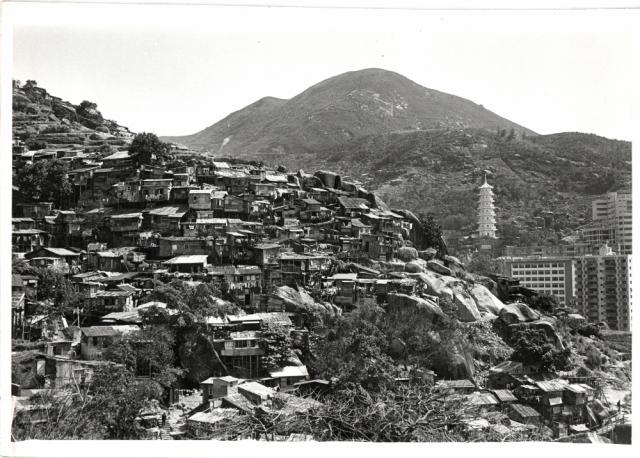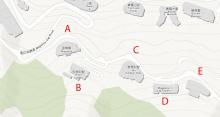Is this the Tiger Balm Garden pagoda in the background, making this the hill above the Tin Hou Temple ?
Squatter huts on the hill
Primary tabs

Submitted by annelisec
Date picture taken (may be approximate):
Wednesday, January 1, 1969
Connections:
- Squatter huts on the hill shows Place Tiger Balm Gardens, or what's left of it. [1935-2002]


Comments
Re: Squatter huts on the hill
Hi there,
Confirmed. That's the place. The Squatter huts were all over the hills back then, from the foothills up to the ridge.
Best Regards,
T
Impressive engineering
how did they stay up on such thin sticks on rock?
Re: Impressive engineering
Hi there,
Some of the clusters of huts might have built by local professional carpenters under influence of Triads or other secret societies. Anyway, do not underestimate traditional Chinese carpentor craftsmanship. We could not judge by the photo exact how thick are the columns of wood, but sometimes these structures use some sort of very straight tree trunks most likely at least as thick as my neck.
Next time if you happen to be going near one of the bamboo scaffoldings in town, to and take a closer look. Some of those major 'trunks' in stregical locatiions on ground level are actually tree trunks as they are much stronger than bamboo. I these scaffoldings had been constructed right, they could withstand very strong winds.
I think there are still some squatters in the out lying islands or the NT these days. Maybe we could have a field trip sometime? I believe Tai-O still have some. If the timing is right and the sky is clear, we could have the most spectacular sunset there.
Best Regards,
T
Suzie Wong
I believe this is the same squatter settlement that was featured (briefly) in The World Of Suzie Wong"
http://gwulo.com/the-world-of-suzie-wong-hong-kong-locations#comment-11172
Squatter huts
I remember many were burnt down in a big fire during the early 60's. Back then, I lived in Causeway Bay with a clear view of the hill and Victoria Park. One early morning at around 4am, I was awaken by nonstop fire truck siren. When I looked out the bedroom window, the entire squatter hillside was on fire and the night sky was bright red. It was an impossible fire to fight as there was no fire hydrant or water supply on the squatter hill.
To this day, that eerie fire scene never left me.
squatters and fire
If you walk up along the left side of HK stadium, there is a path. You reach a chinese memorial to a fire if my memory is right (I've ben there few years ago for the last time). You pass by concrete plateforms. What seems to be remains of (squatters) houses. However it is under tai hang road, overlooking HK stadium, which is right side of former tiger balm garden, thus not the same as the picture which seems to match the area of braemer hill.
It is my understanding of the facts/interpretation. Can anyone comment, confirm/correct me?
tks
nice website btw.
Re: Memorial for fire victims
Hi there,
That's the memorial for the Happy Valley race course fire.
Best Regards,
T
Thanks. A mix up... However
Thanks. A mix up... However do you know about those used-to-be constructions on the side of the same hill?
ff
Re: Fire victis monument
Hi there,
I have not been there yet despite I used to live in Causeway Bay 20 years ago. It was mentioned in an older Chater thread here in this site.
Best Regards,
T
re: Fire Memorial/Cottage Area
Hi ff, I know the area you mean well. It's the old Wesley Village/ So Kon Po resettlement area. More on it here: http://gwulo.com/node/5076
re: Fire Memorial/Cottage Area
Thanks both. I've been wondering about this for years and had no idea the area even has a name... Time to take a trip there again
ff
Squatter Areas & Resetlement
The cottages shown in the above photo was the Ma Shan Squatter Area. It could be accessed from Lin Fa Kung Temple (Lotus Temple) at Wun Sha St in Tai Hang. The area extended from Tai Hang Road to Cloud View Rd opposite Evelyn Court. It had been cleared. Housing Society Lai Tak Tsuen as well as other highrises below have replaced the cottages. I recall there was a major drug case at Ma Shan in the 70s.
The other squatter area was below Tai Hang Road over So Kong Po (the Stadium area). I believe there is still a cottage youth hostel in Wesley Village.
The influx of refugees from Mainland China in the 50s & 60s led to the exponential growth of the population of HK. The shortage of housing was acute. Squatter areas mushroomed and there were overcrowding at old tenement buildings many pre-War & becoming dangerous. I remember one morning, the pedestrian walkways of Kowloon City at Carpenter Road & Junction Road were lined with temporary shelters of people sleeping in the streets after the Shek Keip Mei squatter area fire in 1953. The Government public housing & resettlement programme went into full throttle. Squatter huts were marked for eventual clearance & resttlement. Residents were registered with some documentations proofs of residency required (stamped letters, children report cards, etc...).
Despite the size & lack of facilities of the early Resettlement blocks, the concrete housing with public toilets were eagerly sought after by the Squatters - it was like winning the lottery to be resettled. The flats were very small - I believe the original standard was 25sf for each person (the standard of the Royal Navy?) The crowdedness drove the residents to the open areas of the estate. Primary schools, usually operated by Christian chaitable organisations, were located at the roof, often with open air classrooms.
Flats (rather rooms) were accessed from the outter corridors. Inside the flat, a hole was opened near the ceiling to the adjacent flat for better ventilation; there was little privacy. Kitchens (or rather cooking stoves) were located outside along the corridor. Neighbours passing by could see & smell what one was cooking; one may share a nice dish with the neighbours too. The public toilets were located in the middle junction of the H-blocks for each of the 7 floors. There were no flushing - low waist height concrete partitions with metal gates. A ditch that ran from one end to the other. The ditches were flushed by the Caretakers with a big hose from time-to-time. Parents or brothers stood guard outside the dimly-lid toilets when young girls went to the loo. Drug addicts & robbers & weirdos lurked in the toilets. Police Tactical Units routinely searched these toilets on their Saturation Anti-crime patrols. Rents were collected in cash - the Housing Officers went from unit to unit with an armed guard escorting. Resident Resettlement Officers with quarters in the estate had an harrowing time during the 1967 Riots.
Squatters with shops or cottage-factories could lease ground floor shops at these Resettlement Estates to continue their business. The low rent 'cottage' factories was a key to the success of HK's industry in the 60s when the slogan was - 'Anything you can do we can do better, faster & cheaper.'
Yet amidst these low cost housing areas were a lot of very educated people who were refugees from Mainland China, including some who were intellectuals & top militarists. The low rent helped many entrepreneurs get rich. These estates were where many very successful businessmen & professionals of HK in later years grew up. It was based on this that Home Ownership Scheme of Public Housing was initiated in the early 1970s. With that notion, Resettlement as a welfare programme became Public Housing as a social entreprise & management service.